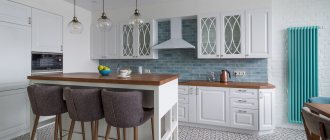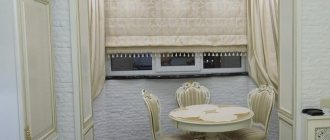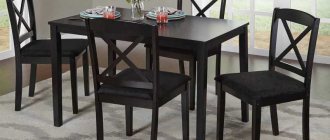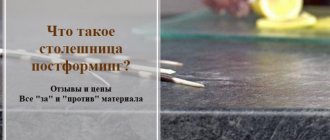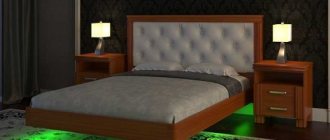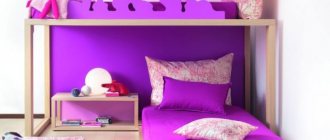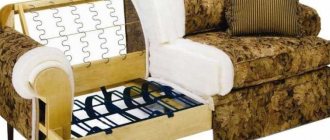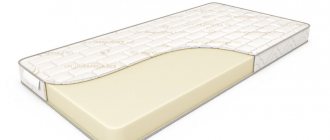There is a saying that theater begins with a coat rack, but it is obvious to everyone that the main thing in the theater is the repertoire and productions, the work of the director and actors, and not at all the wardrobe, buffet or anything else; in the case of a kitchen countertop, a similar statement is one hundred percent true: the kitchen does not just start with the countertop, the table is the main component of kitchen design, its compositional center, the most important piece of furniture that attracts attention more than anything else.
Let's add to this the huge selection of countertops on the modern market - dozens of materials, hundreds of shapes and modifications, and it immediately becomes clear that before choosing a countertop you cannot do without at least a minimal educational program, so as not to make this very choice blindly, trusting other people's reviews and recommendations of sellers - consultants.
Monolithic marble countertops, countertops made of artificial stone, tiled countertops - the supply is so much greater than the demand that your eyes run wild and your hands give up.
Making your own wooden tabletop
Before you begin, you need to determine the dimensions of the surface. Select a suitable height that does not make it difficult to use wall cabinets (optimally 85-90 cm, adjusted according to the owner’s height). The depth, depending on the dimensions of the cabinets, is selected within 60-80 cm. The length is determined by the size and shape of the table.
Required set of tools and materials
Depending on preferences, the surface is made of boards, straight plank, furniture board, or solid wood. To mark and process them you need to stock up on:
- manual or electric planer;
- wood hacksaw, jigsaw;
- drill or screwdriver;
- thicknesser;
- a grinding machine (grinder) with a set of wheels;
- a set of files, sandpaper;
- wood cutter;
- tape measure, square;
- pencil, scriber, chalk.
For assembly and finishing you need to buy:
- stain of the required color;
- antiseptic solution;
- varnish or oil with wax;
- wood glue.
Tabletop made of planks and straight plank
Only well-dried wood is selected, otherwise deformation of the working surface is inevitable. Sequencing:
- The required number of boards or planks are cut to the required length.
- The front side is first processed with a plane and then with a jointer.
- Using an electric jigsaw, grooves are cut on the sides with a width and depth of 10-12 mm on thick boards, and 6-8 mm on thin boards.
- Slats with a thickness equal to the width of the grooves are cut from raw material. It is allowed to make them from plywood.
- These flat bars are inserted into grooves coated with glue on one side of each board.
- After fixing the slats, the future table top is assembled. It is necessary to insert them into the free grooves of adjacent boards, not forgetting the glue.
- The assembled canvas is compressed with clamps.
- After the sticky substance has dried, the sharp edges are milled with a grinder, holes are cut for the sink, pipes, etc.
- Fasteners are installed on the bottom for on-site installation.
- The surface is tinted with stain and treated with an antiseptic.
- The finished structure is varnished or coated with oil and wax.
Table top made of furniture board
The range of panels is presented in samples of different thicknesses and designs. Cheap ones include chipboard with a laminated coating, and expensive ones include solid wood from valuable species. Manufacturing is carried out in the following order:
- A canvas of the required size and shape is cut from the shield.
- A block of wood or several slats are attached to it on the bottom side to increase bending strength.
- If you plan to install the tabletop on legs, they are mounted using fasteners. Fastening to the frame or floor cabinets is done with spikes and corners.
- The surface is ground and polished.
- Treated with a water-repellent compound and painted if necessary.
When purchasing a laminated chipboard board, you should take into account the nuances of working with it. To cover it, a durable, wear-resistant melamine film is used, which tears and peels off when cut with a hacksaw. To avoid damaging it, you need to use a manual or electric jigsaw. The use of an angle grinder is excluded due to increased aggressiveness during work. To cut large sheets, you can use a professional circular saw.
Cutting is carried out as follows: a cut up to 3 mm deep is made along the marking line using a construction knife, then a cut is made along it with a jigsaw. The file should have oblique teeth that cut the material as it moves downwards. By preheating the blade, the edge remains smooth. A guide tape is used to obtain a straight cut.
Combination with plastic
This option is usually used to repair permanently damaged areas of the surface during the manufacture or use of a wooden tabletop. Finding the right plastic is not difficult, since the range of thickness, size and color is extensive. The damaged area is leveled, then the cut sheet is glued to it with liquid nails. The adhesive is applied along the edges of the perimeter and the center. For reliable gluing, a weight is placed on the plastic, and the corners are pressed with clamps.
A material specially designed for the kitchen with a thickness of 1 mm can be used to make an inexpensive chipboard countertop. It withstands moisture and temperature changes, while having high hardness and wear resistance. The installation sites of the sink and hob should be reinforced with bars installed from below on both sides of the holes. The edges can also be lined with plastic, but it is better to make a lining that will increase the strength of the particle board sheet.
Making the cover
To protect the ends of the tabletop, glued or made of panels, a covering made of wooden blocks is installed around its perimeter. They are attached in the same way as boards are attached to each other. For high-quality gluing, compression with clamps is used. The finishing of this part is done together with the canvas.
The lining bars must be harder than the base wood. For example, birch and beech are suitable for edging a spruce tree. Wood dust is used to fill cracks. To increase the strength of the casing, its corners are strengthened with self-tapping screws, having previously drilled holes with a thin drill. They are screwed in obliquely with recessed heads, the recesses of which are hidden with putty.
Reminder for care and use
To ensure that your wooden kitchen countertop retains its beauty for as long as possible, follow the following operating and maintenance rules:
- Try not to place hot dishes on it without a stand. It is advisable that heating devices, for example, a kettle or coffee machine, also stand on some kind of substrate.
- Puddles and drops of water, splashes and stains from coloring juices and products, as well as fat and acids should be wiped off as quickly as possible and not left for more than 2 hours.
- To wash a wooden countertop, just dilute a soap solution from one drop of Fairy or other dishwashing detergent. But caustic products containing chlorine, acids, alcohol, and abrasive particles cannot be used at all. If you clean your stove or oven with grease cleaner, try to avoid letting it come into contact with the wood.
- The countertop should be oiled once a year. However, for the first six months it is advisable to do this as often as possible, for example, once a month. It is very easy to understand that the time has come to restore the protective layer - the surface will begin to absorb drops of water and become slightly rough and faded.
- The varnish on a varnished tabletop needs to be renewed approximately every two years.
- To restore the shine of a wooden tabletop, you must first sand the surface with fine-grit sandpaper (P600 or P800) and then oil it using a soft rag.
- It is advisable to glue/mount some kind of waterproofing underlay under the countertop above the dishwasher.
How to treat a kitchen countertop with oil yourself, watch this video tutorial.
Wood-look countertops
The important qualities of a countertop are not only its practicality and hardness, but also its pleasant appearance.
Today you can find a huge number of options for work surfaces for kitchens or bars, which can imitate the different structures of natural materials. One such option is imitation wood. The fashion for smooth circles, knots, and colors that are pleasing to the eye will never go away. It is probably difficult to choose a material that, in its structure, color variety, and most importantly - naturalness, will give more comfort and warmth to the room where it is used.
It is also interesting that a wooden surface can be either naturally chaotic in design or ordered and precise. All this is achieved thanks to computer-generated drawing on the surface of the tabletop.
Advantages of wooden countertops
A wooden countertop is one of the most practical, functional and successful solutions for the kitchen. Natural wood has a beautiful structure and a rich color palette. It aesthetically fits into the interior of any style - classic, modern, hi-tech, etc.
Despite the fact that the density of wood is much lower than stone, wood countertops are more resistant to chips and scratches due to their good internal elasticity and shock-absorbing properties.
Their main advantages, which lead to wide demand in the market, include:
- Wood is a natural, environmentally friendly and safe material
; it does not emit substances harmful or hazardous to health. - Attractive natural appearance
(a wooden tabletop is ideal for an interior where the emphasis is on natural materials and textures). - The ease of processing wood
allows you to produce products of almost any size and shape, the ability to mill edges. - High resistance to adverse external influences
- humidity, temperature, ultraviolet radiation (with additional protective treatment using oil, wax or varnish). - A variety of decorative options
(the shade and texture of the tabletop depends on the selected type of wood).
If damaged, a wooden tabletop can be easily restored and restored to its original appearance after long-term use.
White kitchen with wood countertops and modern ideas for 2020
A white kitchen with a wooden countertop has become a classic of the genre. This combination appears in many homes - new and renovated - because it is versatile, pleasing to the eye and belongs to the simple but very popular Scandinavian style.
The combination of wood and white warms the interior and brings gentle minimalism. Arranging a kitchen with white furniture and a wooden countertop also offers many possibilities - interior designers are eagerly drawn to this duo, introducing additional decorations that create a unique atmosphere in the kitchen.
The combination of white and wood can be both classic and modern. In such an interior there will be kitchens in a retro style and even in a cool industrial style. The background and decoration of the facades play an important role. If you choose to use gray or clear glass on the wall, the end result will be much more minimalistic than with warm red brick or decorative tiles.
White furniture also tolerates a white background well, and the top then acts as a kind of link between these two surfaces.
When it comes to flooring, many people like to use wood for this kitchen setup, be it in the form of planks, panels or even imitation tiles - it is important that the effect of the wood continues on the lowest plane.
It is very good if the wood on the countertop is the same as on the floor. However, for the more daring, we offer shade combinations and stylish combinations of two different color varieties.
One of the dilemmas when decorating a white kitchen with a wooden countertop is choosing the color of household appliances . The natural solution is to buy a white refrigerator, stove or dishwasher. However, interior designers suggest that there is nothing stopping you from pairing white cabinets with gray or steel appliances and even going a step further and choosing black appliances.
It's the same with the sink. The versatility of a kitchen with wood countertops means the sink doesn't have to be white. Beige, gray or black models also look good.
Choosing wood for the countertop
Firstly, strength. Therefore, the best type of wood for a wooden countertop is one that is hard enough, but at the same time quite stable, that is, it does not change shape under the influence of moisture and heat.
Not every species of hard wood does not swell or dry out, and vice versa: stability of shape, as a rule, does not guarantee the hardness of a product made from such wood.
Sufficiently hard, and at the same time stable types of wood can literally be counted on one hand.
These are, of course, oak, walnut, cherry, black cherry, iroko and teak. A slightly less durable species that makes up for this with its magnificent appearance is pau kijang, a Malaysian deciduous tree not very well known outside of aesthetic circles.
From all of the listed species, Russian Master produces premium wooden tabletops, as well as window sill boards, steps, panels and much more.
Of course, the premium class usually means that the tabletop is made from a solid wood plate, and we have such products in our assortment, but, frankly, this is too expensive and not always advisable, because tabletops made from a solid wood plate are often more susceptible to deformation, than laminated wood countertops.
